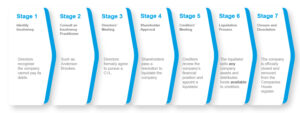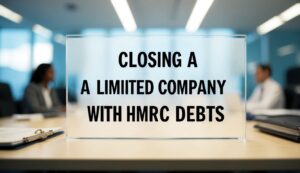Closing a Limited Company with HMRC Debts: Expert Guide
Many UK directors face the difficult decision of closing companies with outstanding HMRC tax debts. This comprehensive guide explains your options, potential risks, and the proper process for closing a limited company with tax arrears owed to HMRC. We are available to discuss your options – please feel free to contact us.
Can I Close a Company with HMRC Tax Debts?
Yes, you can close a company with outstanding HMRC tax debts, but you must proceed carefully and follow the correct legal process. When your company becomes unable to pay its debts, including tax liabilities to HMRC, it has become insolvent. At this point, your duties as a director change significantly – you must now prioritise the interests of creditors above those of shareholders and directors.
HMRC has considerable powers when it comes to debt recovery and typically acts swiftly against businesses that fail to pay their tax obligations. The tax authority views itself as an “involuntary creditor” since businesses are essentially holding money on HMRC’s behalf through VAT, PAYE and other tax collections. This status gives HMRC stronger enforcement powers than many other creditors.
If you’re considering closing your company with outstanding HMRC liabilities, seeking professional advice from a licensed insolvency practitioner is essential to ensure you follow the correct procedures and protect yourself from personal liability.
Voluntary Dissolution is Not an Option with HMRC Debts
Many directors mistakenly believe they can simply dissolve their company by submitting a DS01 form to Companies House when they have outstanding HMRC debts. This approach is not legally appropriate and can lead to serious consequences.
If you attempt to strike off your company while owing money to HMRC, the tax authority will almost certainly object to the dissolution. This objection will suspend your application, leaving the company active on the Companies House register. More concerningly, HMRC may view this as a deliberate attempt to avoid paying tax, potentially triggering more aggressive enforcement action, including a winding-up petition.
Furthermore, the tax authority can apply to have a struck-off company restored to the register even years later, creating ongoing uncertainty and risk for directors. HMRC closely monitors company dissolutions and has dedicated teams focused on preventing tax avoidance through inappropriate company closures.

Free Consultation – advice@andersonbrookes.co.uk or call on 0800 1804 933 our freephone number (including from mobiles).
Creditors’ Voluntary Liquidation: The Proper Way to Close
The appropriate method for closing an insolvent company with HMRC debts is through Creditors’ Voluntary Liquidation (CVL). This formal insolvency procedure provides a structured, legal way to wind up a company that cannot pay its debts, including tax liabilities.
A CVL is initiated by the company directors who appoint a licensed insolvency practitioner to take control of the company’s affairs. The insolvency practitioner will realise the company’s assets, distribute any proceeds to creditors according to the statutory order of priority, and then dissolve the company.
HMRC now holds secondary preferential creditor status for certain tax debts (including VAT and PAYE), which means they rank above unsecured creditors in the distribution of funds during liquidation. However, any tax debts that cannot be repaid from the company’s assets will be written off when the liquidation concludes, providing directors with a clean break from the business.
By voluntarily placing your company into liquidation, you demonstrate to HMRC and other creditors that you are taking responsible action as a director of an insolvent company. This proactive approach can help protect you from allegations of wrongful trading or director misconduct that might arise if you allowed HMRC to force the company into compulsory liquidation.
Voluntary Liquidation Process – Quick Example

HMRC Debt Management and Enforcement Powers
HMRC’s debt management department has extensive powers to recover unpaid taxes. These include:
Taking control of goods through enforcement agents or bailiffs Securing debts against company assets Imposing personal liability on directors in certain circumstances Initiating criminal proceedings for tax evasion Petitioning for compulsory liquidation of the company
If your company has fallen behind with tax payments, HMRC will typically begin with reminder letters and escalate to more serious enforcement action if the debt remains unpaid. The full escalation process can move quickly, particularly for VAT and PAYE arrears, which HMRC views as money being held on their behalf rather than genuine company debt.
When a company enters VAT debt management or PAYE arrears, HMRC may initially offer Time to Pay arrangements for businesses they believe are viable. However, if they suspect insolvency or deliberate non-payment, they can move straight to enforcement action.
For directors facing HMRC pressure, it’s important to understand that continuing to trade while knowingly insolvent can lead to personal liability for company debts. This makes seeking professional advice crucial as soon as tax payment problems arise.
Alternatives to Closing Your Company
Before proceeding with company closure, it’s worth exploring whether your business might be viable with restructuring. Several options may help you address HMRC outstanding debt while keeping your company operating:
The Time to Pay (TTP) arrangement allows eligible businesses to spread tax payments over an agreed period, typically 3-12 months. HMRC assesses each application individually based on your company’s compliance history and financial projections. You’ll need to demonstrate that your business can afford the proposed repayment schedule through detailed cash flow forecasts and sales projections.
A Company Voluntary Arrangement (CVA) is a formal insolvency procedure that allows your company to repay creditors, including HMRC, over an extended period while continuing to trade. This option requires the approval of 75% of creditors by value but can significantly reduce the monthly payment burden while providing protection from creditor action.
For companies with multiple debts alongside HMRC arrears, business restructuring might be appropriate. This could involve closing unprofitable divisions, renegotiating supplier contracts, or refinancing existing debts to improve cash flow.
However, if these alternatives aren’t viable for your situation, liquidation provides a structured way to close your company and deal with outstanding HMRC debts properly.
Personal Risks When Closing a Company with HMRC Debts
Directors need to be aware of potential personal risks when closing a company with HMRC tax debts:
HMRC can pursue directors personally for certain tax liabilities in specific circumstances, such as where National Insurance or PAYE has been deducted from employees but not paid to HMRC, or in cases of VAT fraud.
The insolvency practitioner must investigate directors’ conduct in all liquidations. If they find evidence of wrongful trading (continuing to incur debts when you knew or should have known the company was insolvent) or other misconduct, you could face disqualification proceedings and personal liability.
HMRC has specific powers to make directors personally liable for company tax debts where they suspect tax evasion or fraud, including deliberate non-payment of VAT or PAYE.
If you’ve provided personal guarantees for any company debts, these will remain enforceable despite the liquidation of the company.
By following the proper liquidation process with professional guidance, you can significantly reduce these risks. A licensed insolvency practitioner will help ensure you fulfil your duties as a director and comply with all legal requirements throughout the closure process.
How Anderson Brookes Can Help
At Anderson Brookes, we specialise in helping directors navigate the complex process of closing companies with HMRC tax debts. Our experienced insolvency practitioners provide comprehensive support throughout the closure process. This form part of our company debt solutions service.
We begin with a thorough assessment of your company’s financial position, including a detailed review of all HMRC liabilities across VAT, PAYE, Corporation Tax and any other tax obligations.
Our team can negotiate with HMRC on your behalf, potentially securing Time to Pay arrangements if your company has viable prospects for recovery and tax debt settlement.
If liquidation is necessary, we handle the entire CVL process from initial documentation to creditor communications and final dissolution, ensuring all statutory requirements are met.
Throughout the process, we provide clear guidance on director responsibilities and obligations to help protect you from personal liability risks associated with company closure.
Many directors don’t realise they may be entitled to redundancy payments when their company enters liquidation. Our team can assist with these claims, which can provide valuable financial support during this challenging transition.
Contact Us for Expert HMRC Debt Advice
If you’re concerned about closing your limited company with outstanding HMRC debts, contact Anderson Brookes for confidential, expert advice from our team of licensed insolvency practitioners.
For a Free Consultation, email advice@andersonbrookes.co.uk or call our freephone number 0800 1804 933 (free from mobiles).
Our experienced team will help you understand your options and guide you through this challenging process with minimal stress and risk. With proper professional guidance, you can ensure your company closure is handled legally and ethically, protecting your future interests and career while appropriately addressing your obligations to HMRC.
You may also like:
Free Consultation – advice@andersonbrookes.co.uk or call on 0800 1804 933 our freephone number (including from mobiles).
Google Reviews

&



